Luminaries Home
2015 CONVENTION, WAYNESVILLE, MO
STAN SIDES
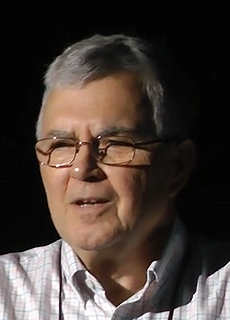 Dr. Stanley D. Sides became a member of the NSS while still a young boy growing up in the southeastern portion of Missouri. Beginning his caving career close to home, Stan, plus two of his ham radio friends, squeezed through a tight keyhole in a cave near Perryville and had the joy of exploring a walking stream passage for the next 5 hours. This cave, now known as Crevice Cave, is Missouri’s longest cave with over 30 miles of surveyed passage. Dr. Stanley D. Sides became a member of the NSS while still a young boy growing up in the southeastern portion of Missouri. Beginning his caving career close to home, Stan, plus two of his ham radio friends, squeezed through a tight keyhole in a cave near Perryville and had the joy of exploring a walking stream passage for the next 5 hours. This cave, now known as Crevice Cave, is Missouri’s longest cave with over 30 miles of surveyed passage.
Barbara MacLeod was introduced to Stan at his first MVOR, and she became a catalyst for Stan’s future adventures. Barb wrote to Stan and mentioned that she had participated in some work at Floyd Collins Crystal Cave. Thus informed, Stan would soon be catching a Greyhound bus to St. Louis in order to join up with Red and Patty Jo Watson for a ride in their VW van to CRF expeditions. Stan did numerous trips with the CRF, including surveys of the Bretz River complex. In addition, he participated in expeditions that pushed and surveyed miserable passages under Houchins Valley. To this day, Stan continues his documentation of the historic names and cultural uses of the more obscure caves under Flint Ridge. Download a copy (58:47, 156 MB)
DIANA NORTHUP
 Diana Northup is world-renowned for her pio- neering work in helping to understand and explain the fascinating mysteries of cave microbes. In addition, Diana is co-author of the monumental publication entitled A Guide to Speleo- logical Literature of the English Language 1794–1996. Diana Northup is world-renowned for her pio- neering work in helping to understand and explain the fascinating mysteries of cave microbes. In addition, Diana is co-author of the monumental publication entitled A Guide to Speleo- logical Literature of the English Language 1794–1996.
With her wit, knowledge, and wide experience, Diana Northup is a sought-after speleologist, public speaker, and television personality. She has been featured in a NOVA episode entitled “Mysterious Life of Caves,” in a National Geographic presentation called “Death Valley,” in a Discovery Channel episode asking “Are We Alone?,” and in a documentary entitled “Life in the Solar System” produced by the British Broadcasting Corporation.
Dr. Northup is particularly fascinated with caves that are very hostile to human existence, but apparently friendly to microbial life. It is believed that such places may provide guidance as to where such extremophiles might thrive elsewhere in our solar system. Download a copy (47:36, 191 MB)
BILL STEELE
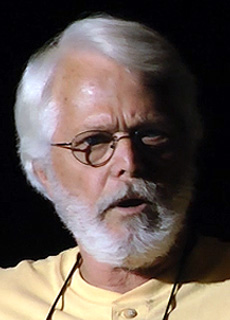 If there is a single word to describe Bill Steele, that word would be “Explorer.” Since childhood, Bill’s path in life was clear: he would devote his time, his money, his attention, and his pas- sion toward unraveling the mysteries of the under- ground. If there is a single word to describe Bill Steele, that word would be “Explorer.” Since childhood, Bill’s path in life was clear: he would devote his time, his money, his attention, and his pas- sion toward unraveling the mysteries of the under- ground.
Steele has done extensive explorations in Indiana, in TAG, in Kentucky, in Texas, in Montana, in Oklahoma, in Arkansas, in China, and in Mexico. Bill was a key member of Richard Schreiber’s original descent trip to 440-foot-deep Incredible Pit in Ellison’s Cave, Georgia. And, during an intense summer camped at the north cirque on Montana’s Silvertip Mountain, Steele and company bashed away in multiple, albeit unsuccessful, attempts to make the Silvertip complex the deepest cave in the United States.
Bill Steele is perhaps best known for his work in, and writings about, Sistema Huautla. Capturing three decades of effort from his own point of view, Bill authored the popular book Huautla: Thirty Years in One of the World’s Deepest Caves. Bill also wrote Yochib: The River Cave, and co-authored a chapter in Encyclopedia of Caves. Download a copy (1:04:12, 178 MB)
2014 CONVENTION, HUNTSVILLE, AL
JOHN COLE
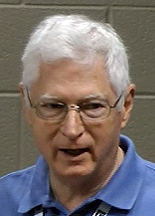 John Cole was active with a group of enthusiasts—including John Patten, Bill Cuddington, and others—whose focus was on the development of improved methods for descending and ascending deep pits. While considering the descending problem, Cole had a brainstorm. Why not, he reasoned, employ commercial brake bars arranged just so on a U-shaped frame? One end of this bent frame could be rolled into a loop for carabiner attachment, while the other end could accommodate a machine nut in order to prevent these brake bars from unexpectedly depopulating the frame. Cole’s rappel rack quickly gained fame throughout the U.S. as the favored way to "get down." John Cole was active with a group of enthusiasts—including John Patten, Bill Cuddington, and others—whose focus was on the development of improved methods for descending and ascending deep pits. While considering the descending problem, Cole had a brainstorm. Why not, he reasoned, employ commercial brake bars arranged just so on a U-shaped frame? One end of this bent frame could be rolled into a loop for carabiner attachment, while the other end could accommodate a machine nut in order to prevent these brake bars from unexpectedly depopulating the frame. Cole’s rappel rack quickly gained fame throughout the U.S. as the favored way to "get down."
Cole performed difficult explorations and mapping in the southeastern United States, in Europe, and in Mexico. John was a member of the team that did the very first descents of Golondrinas in April 1967—tandem prusik climbing out of this 1,094-foot drop on a Samson rope just above his friend Bill Cuddington. This expedition was the first time that a 1,000-foot pit had ever been explored with rappel and prusik methods. Download a copy (51:06, 92 MB)
JOHN HOLSINGER
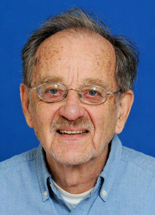 Holsinger began his exploration of caves as a Virginia Tech student in the 1950s and participated in many milestones during the course of his caving career. John was a key member of the team on Lew Bicking’s first visit to the now-famous Crookshank Pit in West Virginia. Later, in his home state of Virginia, John led a series of biological and survey explorations into Endless Caverns. During these adventures, Holsinger and company found one of the historic bottles intentionally left behind by the Explorers Club at the point of their farthest upstream penetration in 1925. Holsinger began his exploration of caves as a Virginia Tech student in the 1950s and participated in many milestones during the course of his caving career. John was a key member of the team on Lew Bicking’s first visit to the now-famous Crookshank Pit in West Virginia. Later, in his home state of Virginia, John led a series of biological and survey explorations into Endless Caverns. During these adventures, Holsinger and company found one of the historic bottles intentionally left behind by the Explorers Club at the point of their farthest upstream penetration in 1925.
Dr. Holsinger performed his graduate work at the University of Kentucky under the supervision of Tom Barr. Always interested in cave life, John has studied, collected, and described cave fauna in both Virginia and West Virginia.
In addition to his many accolades from both the scientific and caving communities, Dr. John R. Holsinger enjoys perhaps the finest nickname ever linked to a caver—namely, “Captain Karst.” Download a copy (54:16, 61 MB)
DOUG AND HAZEL MEDVILLE
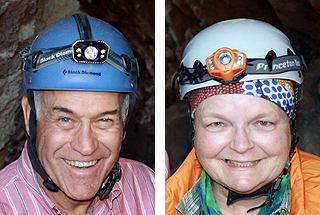
Doug and Hazel Medville are one of the most accomplished couples in American caving. Their caving careers began in the Appalachians during the mid-1960s. Along the way they conducted discoveries, explorations, and survey work in hundreds of caves. Doug served as the exploration and survey coordinator for the Friars Hole project that, in the 1970s, helped to make Friars Hole the seventh longest cave in the world during that era.
The Medvilles began exploring and surveying caves in the Tetons and the Gros Ventre Mountains in the 1970s. They found what was, at the time, the deepest cave in Wyoming and surveyed over 100 alpine caves. Doug and Hazel remain active in Colorado and environs. Over the past several decades, the couple has made numerous trips to Hawai’i that have resulted in their surveying more than 90 miles of lava tubes, GPS-ing over 1,800 entrances, and making numerous original discoveries.
Doug and Hazel penned the first Bulletin of the WV Speleological Survey, the Caves of Randolph County. Later, they put together Bulletin 6, Caves and Karst Hydrology in Northern Pocahontas County.
Doug and Hazel Medville are living proof that intelligent, observant, and systematic cavers can make major contributions to the field even without formal academic degrees in the usual disciplines. For their pioneering exploration, mapping, and publishing, the Medvilles received the prestigious Lew Bicking Award in 1971—the first husband and wife team to do so. In addition, they both have been honored with the Certificate of Merit and with the Stephenson Outstanding Service Award. Download a copy (59:37, 181 MB)
|


 Dr. Stanley D. Sides became a member of the NSS while still a young boy growing up in the southeastern portion of Missouri. Beginning his caving career close to home, Stan, plus two of his ham radio friends, squeezed through a tight keyhole in a cave near Perryville and had the joy of exploring a walking stream passage for the next 5 hours. This cave, now known as Crevice Cave, is Missouri’s longest cave with over 30 miles of surveyed passage.
Dr. Stanley D. Sides became a member of the NSS while still a young boy growing up in the southeastern portion of Missouri. Beginning his caving career close to home, Stan, plus two of his ham radio friends, squeezed through a tight keyhole in a cave near Perryville and had the joy of exploring a walking stream passage for the next 5 hours. This cave, now known as Crevice Cave, is Missouri’s longest cave with over 30 miles of surveyed passage. If there is a single word to describe Bill Steele, that word would be “Explorer.” Since childhood, Bill’s path in life was clear: he would devote his time, his money, his attention, and his pas- sion toward unraveling the mysteries of the under- ground.
If there is a single word to describe Bill Steele, that word would be “Explorer.” Since childhood, Bill’s path in life was clear: he would devote his time, his money, his attention, and his pas- sion toward unraveling the mysteries of the under- ground. John Cole was active with a group of enthusiasts—including John Patten, Bill Cuddington, and others—whose focus was on the development of improved methods for descending and ascending deep pits. While considering the descending problem, Cole had a brainstorm. Why not, he reasoned, employ commercial brake bars arranged just so on a U-shaped frame? One end of this bent frame could be rolled into a loop for carabiner attachment, while the other end could accommodate a machine nut in order to prevent these brake bars from unexpectedly depopulating the frame. Cole’s rappel rack quickly gained fame throughout the U.S. as the favored way to "get down."
John Cole was active with a group of enthusiasts—including John Patten, Bill Cuddington, and others—whose focus was on the development of improved methods for descending and ascending deep pits. While considering the descending problem, Cole had a brainstorm. Why not, he reasoned, employ commercial brake bars arranged just so on a U-shaped frame? One end of this bent frame could be rolled into a loop for carabiner attachment, while the other end could accommodate a machine nut in order to prevent these brake bars from unexpectedly depopulating the frame. Cole’s rappel rack quickly gained fame throughout the U.S. as the favored way to "get down." Holsinger began his exploration of caves as a Virginia Tech student in the 1950s and participated in many milestones during the course of his caving career. John was a key member of the team on Lew Bicking’s first visit to the now-famous Crookshank Pit in West Virginia. Later, in his home state of Virginia, John led a series of biological and survey explorations into Endless Caverns. During these adventures, Holsinger and company found one of the historic bottles intentionally left behind by the Explorers Club at the point of their farthest upstream penetration in 1925.
Holsinger began his exploration of caves as a Virginia Tech student in the 1950s and participated in many milestones during the course of his caving career. John was a key member of the team on Lew Bicking’s first visit to the now-famous Crookshank Pit in West Virginia. Later, in his home state of Virginia, John led a series of biological and survey explorations into Endless Caverns. During these adventures, Holsinger and company found one of the historic bottles intentionally left behind by the Explorers Club at the point of their farthest upstream penetration in 1925.